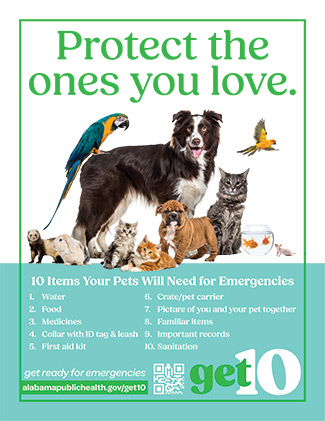Get 10 for Pets
 Be your pet's hero. Protect the "other" ones you love!
Be your pet's hero. Protect the "other" ones you love!
Get a Supply Kit
Just as you do with your family’s emergency supply kit, think first about the basics for survival, particularly food and water. Consider making two kits. In one, put everything your pets will need to stay at home. The other should be a lightweight, smaller version you can take with you if you and your pets have to get away. Plus, be sure to review your kits regularly to ensure that their contents, especially foods and medicines, are fresh.
10 Items Pets Need for Emergencies
1. Water—Store at least three days of water specifically for your pets.
2. Food—Keep at least three days of food in a waterproof container.
3. Medicines—Keep extra supply in a waterproof container.
4. Collar with ID tag and leash—Should wear collar with rabies tag and identification at all times. Include backup collar, ID tag, and leash.
5. First Aid Kit—Talk to your veterinarian about what is most appropriate for your pet. Most kits should include cotton bandage rolls, bandage scissors and tape, antibiotic ointment, flea and tick prevention, latex gloves, isopropyl alcohol, and saline solution.
6. Crate/Pet Carrier—Carrier should be large enough for your pet to stand, turn around, and lie down.
7. Picture of you and your pet together—If you become separated a picture could help document ownership.
8. Familiar Items—Put favorite toys, treats, or bedding in your kit to help reduce stress of pet.
9. Important Records—Keep a copy of your pets’ vaccinations, medical records, veterinarian information, and any other important documents in a waterproof container.
10. Sanitation—Include newspapers, paper towels, plastic trash bags, shampoo, bleach, and if appropriate, pet litter box and litter.
Arrange a Safe Haven
- Contact your veterinarian for a list of preferred boarding kennels available in event of an emergency.
- Check with local animal shelters to see if they provide temporary emergency shelter.
- Choose a designated caregiver outside of your immediate area to take care of your pet.
Evacuation Preparation
- Store the emergency kit as close to an exit as possible.
- Make sure all pets are wearing collars with current identification.
- Always bring pets indoors at the first warnings of a storm.
- Consider your evacuation route and call ahead to make arrangements for boarding your pet outside of the disaster area.
Additional Information
Page last updated: September 25, 2025




